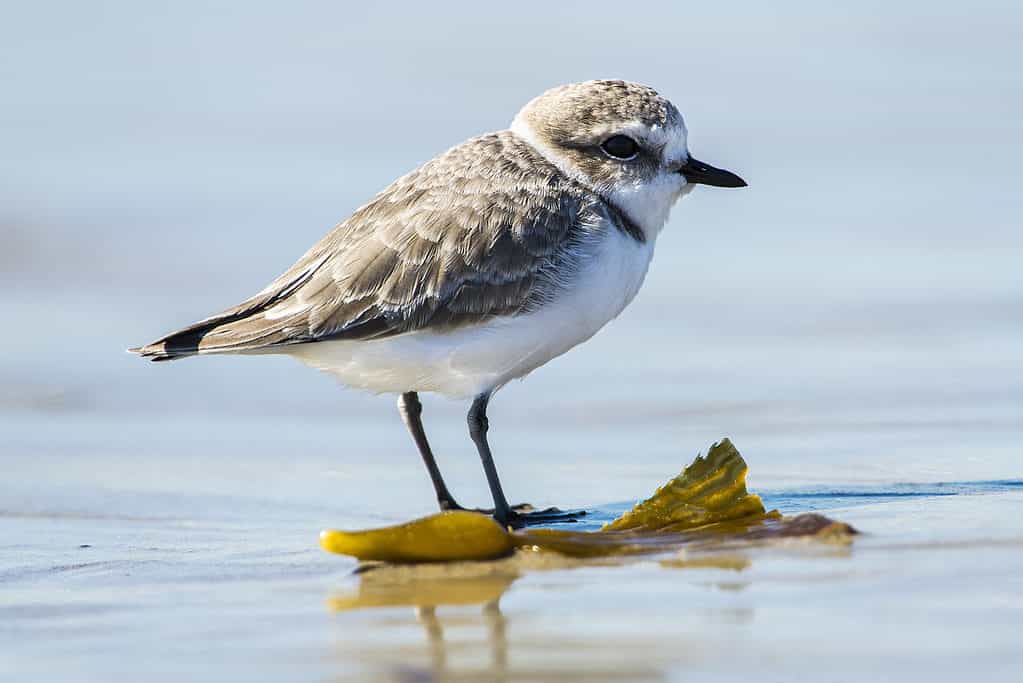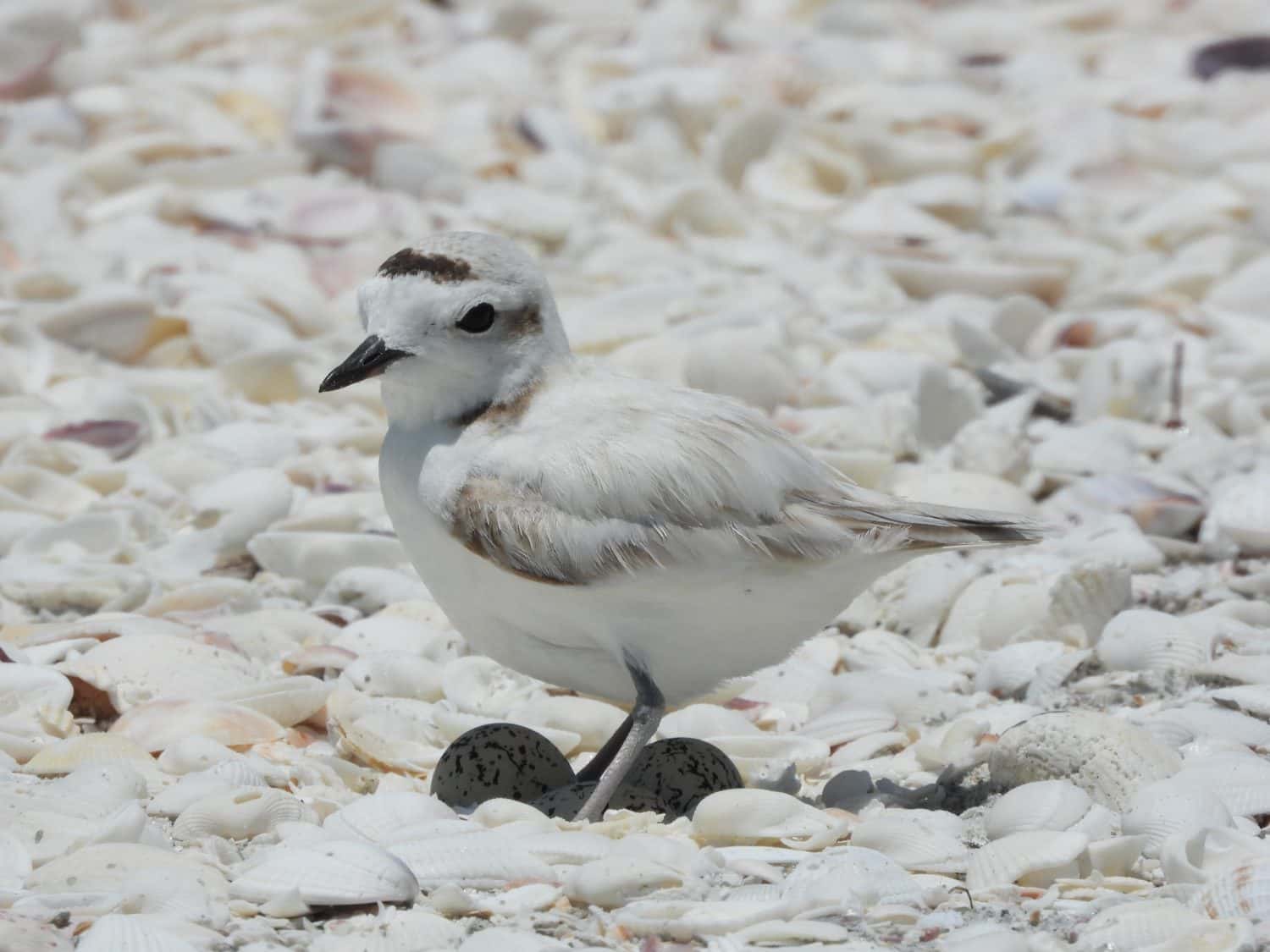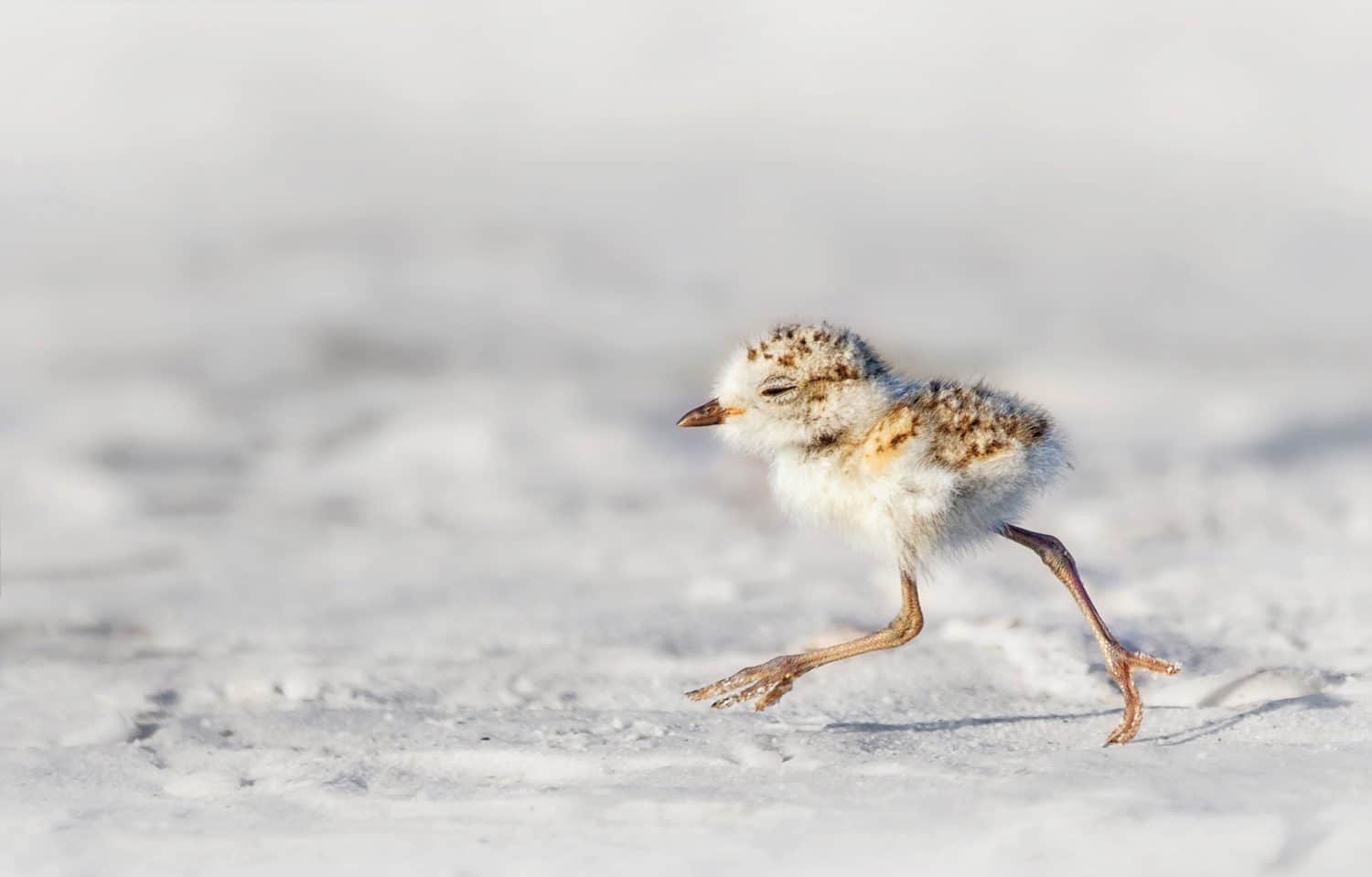Nearly half of the Snowy Plover population in North America breeds in a limited range on the salt plains of Utah and Oklahoma. This tiny migratory shorebird makes its home primarily on the coasts and on the flats near salty inland bodies of water. The near-threatened species has a population of mature adults estimated as low as 24,000 and is thought to be decreasing. Snowy Plovers face an array of threats, from predators to habitat degradation. The tiny, adorable birds thrill birdwatchers, but their nests are so difficult to spot that the very act of walking through their habitat can lead to their destruction. Let’s learn more about the fascinating Snowy Plover, where it lives, how it breeds, and what it will take to ensure the long term survival of the species.
Scientific Background of the Snowy Plover
The Snowy Plover, Anarhynchus nivosus, belongs to the order Charadriiformes. This order of birds includes most wading shorebirds, along with gulls and auks. The Charadriidae family includes the plovers, dotterels, and the larger lapwings. The taxonomic organization of birds within this family, like many others, has undergone much change in recent decades.
Although the Snowy Plover was first described in 1858 by John Cassin, a prominent American ornithologist, the bird was misclassified for the better part of a century. From 1922, scientists classified the Snowy Plover as a subspecies of the similar Kentish Plover of Europe. In 2011 technology freed the bird from this error, as researchers used DNA evidence to reclassify the Snowy Plover as a species in and of itself.
Further disruption to the bird’s taxonomic distinction took place in the following years. The species belonged to the Charadrius genus of plovers until recently. Following studies conducted beginning in 2015, scientists with the International Ornithologists’ Union moved them, along with 22 other species, to the Anarhynchus genus. The newly updated IOC World Bird List, Version 14.1, now categorizes the species as Anarhynchus nivosus, rather than Charadrius nivosus, though it may take time for other authorities to recognize the change.
Currently, scientists have some disagreement over how many subspecies of Snowy Plovers exist. They agree that those members of the species living in the western half of North America, including those in Oklahoma and Utah as well as well as the coastal residents, belong to the subspecies, Anarhynchus nivosus nivosus. And they concur that the populations living in coastal South America belong to the subspecies, A. nivosus occidentalis. However, opinions differ as to whether the birds living in the southeastern United States and the Caribbean belong to a third subspecies, A. nivosus tenuirostris.
Appearance

The Snowy Plover (Charadrius nivosus) has black markings around its head during breeding season.
©iStock.com/drferry
The Snowy Plover is a cute little bird shaped somewhat like an egg. It has a short neck and a rounded body and head with a short, pointed, black bill and a short tail. These birds measure only about 5.9 to 6.7 inches in length, and they weigh between about 1.1 to 2.0 ounces. Their size measures about the same as an Eastern Bluebird. They have longer legs than most songbirds, but they do not have exceptionally long legs as compared to other shorebirds.
Snowy Plovers have light colored feathers that blend well with their sandy surroundings. They have light, sandy brown feathers on their upper parts, and they have white feathers underneath. During the breeding season, these birds show black markings on their head and breast. They have a black crown at the front of their head, a partial black eyeline, and a black partial collar at the top of the breast, toward their sides. Juveniles lack the black markings.
Where Does the Snowy Plover Live?

Snowy Plovers live primarily in areas of low vegetation around salty bodies of water.
©Zhaodong Chen/Shutterstock.com
Snowy Plovers live primarily on the coasts and on salt flats near inland saline lakes. Roughly 42 percent of existing members of this species live in just two small areas of the United States: near the Great Salt Lake in Utah and on the similarly saline Salt Plains National Wildlife Refuge in northwestern Oklahoma. Smaller populations also live around inland wetlands in the western half of the United States and in Mexico. Most of the rest, however, reside along the coasts of North America, western South America, Central America, and parts of the Caribbean.
The Anarhynchus nivosus occidentalis subspecies resides year-round along the western coast of South America from Ecuador to Chile. The Anarhynchus nivosus nivosus subspecies lives in North America from the state of Washington all the way down the Pacific coast to Costa Rica. It also inhabits some inland habitats west of Louisiana, along with the eastern coast of the Gulf of Mexico. The Snowy Plover population east of Louisiana is thought to consist of the more recently distinguished Anarhynchus nivosus tenuirostris subspecies.
These birds stick mainly to flat wetland areas with little vegetation, particularly around saline bodies of water, including the ocean, salty inlets and wetlands, and saline lakes or ponds. They may also inhabit grasslands near wetland areas. They can fly, but they spend most of their life on the ground, where they search for food and raise their young.
Where Do They Nest?

A Snowy Plover’s nest consists of a shallow scrape on the ground.
©CamandBelleStudio/Shutterstock.com
The Snowy Plover nests on the ground. Their nest, made by the male, consists of a mere scrape on the ground. Snowy Plover nests blend in so well with their surroundings, they are virtually invisible. They prove so difficult to see, even trained researchers have a difficult time seeing them. Walking across Snowy Plover habitat can easily disrupt nests or destroy eggs. The nests of this species offer little to no protection from predators other than their camouflage against the wide-open space.
Reproduction

Young Snowy Plovers fledge between about 29 to 47 days.
©Kristian Bell/Shutterstock.com
Snowy Plovers form pairs at the beginning of each nesting season in the spring. Males begin to establish a territory before the arrival of females. Each male prepares by finding several suitable nest sites within his territory. Males vigorously defend their territories and compete for the attention of females. Once a female shows interest, the male begins making scrapes at his nest sites, in hopes that the female will settle there. If she does, they will mate and soon produce a clutch of between 2 to 6 eggs.
Both the male and female Snowy Plover take turns incubating their clutch. Females spend most of the time on the nest, while males tend to incubate the eggs sometime during the night. Unlike most bird species, many female Snowy Plovers tend to take off soon after their eggs hatch. These females fly away within about 6 days after their hatchlings emerge. They leave their male mates to tend to the offspring until they fledge. Offspring fledge at about 29 to 47 days after hatching.
The female Snowy Plovers that leave their young look for a new mate. They often settle down far away from the first male’s territory. They produce a second clutch, and sometimes even a third before the summer ends. Males, too, may find a new mate after their first clutch fledges, or sooner if their offspring meet an untimely end.
Behavior
Snowy Plovers behave aggressively toward other birds, including those of their own species, during their breeding season. They defend their territories vigorously and males will readily fight one another to protect their claims. However, once breeding season ends, the birds will gather in large flocks. Those that migrate tend to do so in large numbers.
Diet
The Snowy Plover eats mainly insects, especially beetles and flies, and other invertebrates and their eggs or larvae. They may ambush a swarm of flies catching prey in midair. More often, this tiny bird stands still while it surveys the flat and mostly barren landscape it calls home. When it spots prey, it runs across the ground and quickly attacks. Snowy Plovers can pluck insects, worms, and arthropods right out of the sandy soil with their sharp bills. They often give their prey a few strong chomps with their bill. Sometimes they even cut them in half before swallowing them.
Is the Snowy Plover Rare?
The IUCN Red List of Threatened Species categorizes the Snowy Plover as near threatened. As of the latest assessments, it has an estimated population of just 24,000 to 31,000 mature individuals worldwide. Approximately 42 percent of those live in just two locations in the United States. Conservation efforts aimed at protecting the Snowy Plover have been largely ineffective. These have included restoring waterways, altering the terrain of potential habitat, blocking access to known nesting areas. Scientists have also attempted to prevent predators from reaching nesting birds, among other efforts.
Some of the greatest threats to the Snowy Plover include habitat degradation due to construction and recreation. Changes to waterways and wetlands, as well as wildfires and droughts have had negative effects. They suffer losses due to crushed nests and eggs, and of course predators including birds such as falcons, crows, and owls, mammals, and reptiles. Scientists are continuing to study the Snowy Plover and make efforts to help the species recover. Mainly they are working however they can to preserve and protect their habitat.
Target Word Count for this post is less than 1750.
The photo featured at the top of this post is © Agami Photo Agency/Shutterstock.com
Thank you for reading! Have some feedback for us? Contact the AZ Animals editorial team.






